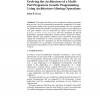1129 search results - page 13 / 226 » Multi-chromosomal genetic programming |
BMCBI
2008
13 years 7 months ago
2008
Background: Genetic association studies have been used to map disease-causing genes. A newly introduced statistical method, called exhaustive haplotype association study, analyzes...
EPS
1995
Springer
13 years 11 months ago
1995
Springer
: This paper describes six new architecture-altering operations that provide a way to dynamically determine the architecture of a multipart program during a run of genetic programm...
GPEM
2002
13 years 7 months ago
2002
A representation-less model for genetic programming is presented. The model is intended to examine the mechanisms that lead to bloat in genetic programming (GP). We discuss two hyp...
AIIA
1995
Springer
13 years 11 months ago
1995
Springer
Genetic Programming (GP) is a method of automatically inducing programs by representing them as parse trees. In theory, programs in any computer languages can be translated to par...
PRICAI
2004
Springer
14 years 23 days ago
2004
Springer
Abstract. A successful case of applying brute-force search to functional programming automation is presented and compared with a conventional genetic programming method. From the i...


